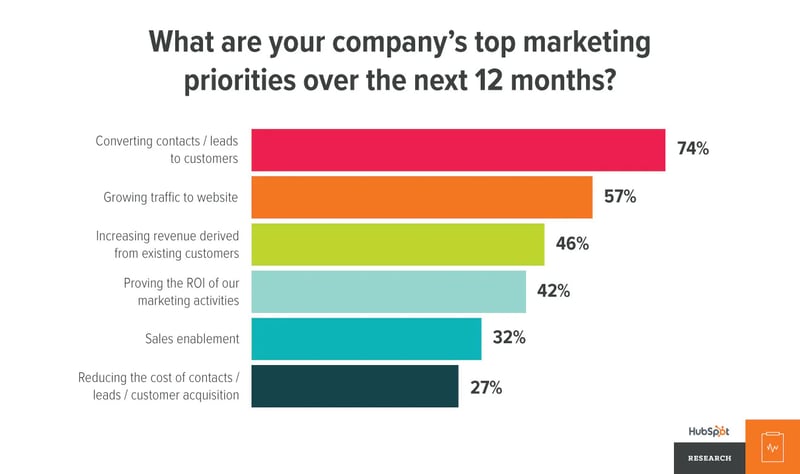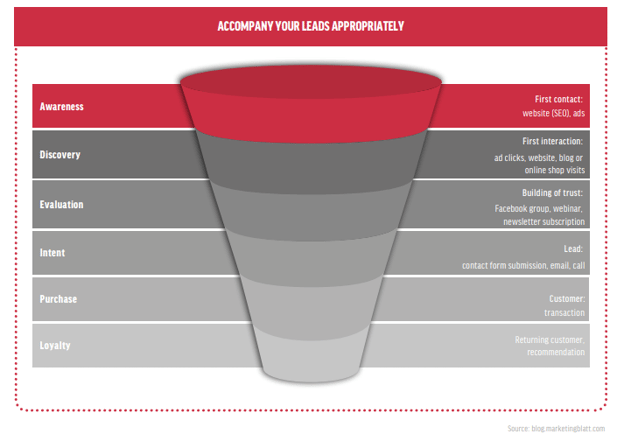We have already dealt extensively with the topic of lead generation. But what exactly is to be done once the leads have been generated? How can you develop your leads into qualified leads and ultimately into (long-term) customers? Lead Nurturing deals with this question. The term comes from the English word "nurture". Accordingly, lead nurturing is about the care, promotion and management of contacts. The goal is to push the further development of contacts along the sales funnel and thus build a comprehensive customer relationship. The marketing measures with which the lead is accompanied are decisive. It is important to offer the right content at the right time in order not to lose the attention and interest of the lead. Without an adequate accompaniment of the leads, they can quickly lose interest in your products or services and the bounce rate is very high. A well thought out lead scoring can help you to better score the leads and thus target your campaign more optimally. Would you like to learn more about lead nurturing? Then read our white paper on the topic now:
You can also find more information on lead generation on our website HERE. Take a look!
If you use lead nurturing to qualify the lead further and further until it becomes a purchase, you have not only gained a customer, but also confirmation that your sales funnel works in combination with attractive lead nurturing. Once an attractive lead nurturing process has been established, it can and must be kept up to date in order to achieve a continuous increase in sales.
Table of contents:
- What is Lead Nurturing and what advantages does it offer?
1.1. Advantages of Lead Nurturing
1.2. Types of Nurtures
1.3. The Role of Lead Nurturing in the Sales Funnel - The Lead Nurturing Process
2.1. Building a Lead Nurturing Campaign
2.2. The Role of Content in Lead Nurturing - Strategies and Tips for Successful Lead Nurturing
3.1. Proven Strategies and Tips
3.2. Considering Data Protection in Lead Nurturing - Measuring the effectiveness of lead nurturing
4.1. Key KPIs of Lead Nurturing
4.2. Lead scoring - Conclusion
WHAT IS LEAD NURTURING AND WHAT ADVANTAGES DOES IT OFFER?
Lead Nurturing deals with the qualitative development of the customer relationship – from the potential customer to the loyal long-term customer. It is the task of the marketing and sales staff to accompany the (potential) customer all the way from awareness (gaining attention/interest) to purchase (the decision to buy). In each phase of the sales funnel or marketing funnel, the user must be served with suitable materials, information and communication offers that neither overwhelm him nor make him lose interest. – A real balancing act!
Advantages of Lead Nurturing
Lead Nurturing offers a multitude of advantages for companies that want to accompany potential customers efficiently and promisingly through the marketing and sales process.Of course, the advantages vary depending on the scope and setup of the lead nurturing process. In general, however, it can be stated that lead nurturing helps to increase the effectiveness of the marketing and sales process, improve the relationship with potential customers and ultimately increase sales.
Advantages at a glance:
- Increase the conversion rate: Through targeted and comprehensive lead nurturing, potential customers are better informed and addressed. As a result, more leads convert to customers.
- Better customer relationships: Through regular and relevant interactions with (potential) customers, companies can build and strengthen customer loyalty.
- Time and cost savings: Automation is the key word here! Through automated lead nurturing campaigns, companies save time and can use their resources more efficiently. In addition, employees are relieved, who in turn can focus on the core business.
- Target group-specific addressing: Modern lead nurturing tools enable companies to provide personalised content that is tailored to the needs of the leads. This aspect in turn increases the chances of a positive response.
- Shortening the sales cycle: Through engaging lead nurturing, leads can be qualified and prepared for the sales department more quickly.
- Reactivating inactive leads: Users who have already had contact points with the company, e.g. through a website visit and an online registration, but who have not shown any further interest, can be addressed again by means of lead nurturing measures, led back into the sales funnel and thus reactivated.
- Improved measurability: Thanks to modern technologies and the use of marketing automation tools, the decisive KPIs as well as detailed analyses can be generated that show the optimisation potential of a lead nurturing campaign.
- Conveying expertise: Adequate, unobtrusive yet supportive guidance of leads through the buying process by means of relevant and valuable content conveys expertise and presents your company as a pleasant service provider. It also allows you to stand out from the competition.
Types of Nutures
In lead nurturing, a distinction is made between three different types of "nurtures".
Welcome Nurture: A "Welcome Nurture" (also called "Onboarding Nurture" or "Welcoming Nurturing") is a specific type of lead nurturing process that focuses on new (potential) customers. This usually involves an automated communication strategy that greets the (potential) customer immediately after the conversion of a lead and, if necessary, makes a further offer of information. An example of this could be an automated email after a newsletter subscription, thanking the customer for subscribing and referring to further content such as the company's blog. The contacts' need for information is quite high at this stage and can be used to generate further information about the contact.
Follow Up Nurture: Here you have already gathered specific information about the lead and can refer to previous actions of the lead as well as "follow up". Perhaps thanks to certain actions of the lead, you can assign them to a specific segment so that they can now receive personalised, topic-specific and targeted content. Or the lead may have attended one of your company's webinars and you can then provide them with further content to move them up the sales funnel.
Wake Up Nurture: If a lead has not been active for a long time and hardly has your company on their radar, wake up nurtures can revive the relationship.
This could be, for example, a reminder email to confirm the subscription to the newsletter.
The role of lead nurturing in the sales funnel
For 74% of companies, converting leads into customers is the top priority (source: HubSpot).

Many companies have thus recognised that the nurturing and further development of leads is crucial for the company's success. But how exactly does one implement lead nurturing in a promising way? This is strongly dependent on the quality of the lead. The first question is how well the contact matches the personas or the target group of the company. If there is a potential match here and a good chance that the lead can qualify further, it is advisable to group the prospects. The criterion here is how exactly the prospect engages with the company. Does the contact simply want to obtain information without pursuing a real purchase intention, for example by reading up on the company's blog? Or does he already show a concrete interest in products, for example by downloading a product brochure? The more a prospect interacts with the company and its communication offers and the more specific the actions are, the greater the chance that the lead will convert. For the correct evaluation of the lead in this familiarisation phase and the following phases, a professional lead scoring is very helpful, which also takes micro conversions into account. Through this evaluation, the different phases of the sales funnel in which the leads are located also become clear.
Based on the respective phase of the "sales funnel", it can be decided which communication offer the leads will best receive in order to move further through the sales funnel if possible.
Example of lead development along the sales funnel:
THE PROCESS OF LEAD NURTURING
Set up a lead nurturing campaign
The structure of lead nurturing runs roughly along the sales funnel. In the following, we present the different lead nurturing phases, which serve as the basis for building a nurturing campaign.Enquiry (request for information):
The lead (Marketing Qualified Lead / MQL) is looking for information. This can be of a general nature on a topic or more specific to a particular problem. Here, companies can position themselves as experts with various information offers or draw attention to a product or service.
Sales Accepted Lead (SAL):
In this phase it is already more concretely about a problem solution or question. Now a first personal contact between the prospect and the sales team can be established in order to support the lead in solving the problem.
Sales Qualified Lead (SQL, sales opportunity):
At this point, the prospect already deals in detail with concrete products or services to solve the problem/question. It is now imperative that sales people act and offer relevant details about products and services.
Closed Won (purchase completion):
The lead has decided to buy because of the appealing and comprehensive information offered. A customer has been won, who can of course be provided with further information afterwards. For example, according to the motto "Customers who bought this product also bought ...".
This structure shows that the sales funnel and lead nurturing go hand in hand and, when planned in combination, represent a promising model for success.
The role of content in lead nurturing
It is already clear from the phases of the lead nurturing process that the content offered plays a decisive role. It must be specific to each phase a lead is in. Offering too much, too specific or too detailed content too early can have an overwhelming and intrusive effect, which can be off-putting. The content must also be relevant to the lead at the stage they are at and provide useful information.
The timing of the content is also important. If you offer content too quickly one after the other, this can also be intrusive. The day of the week and time of day may also be important. Sending newsletters for B2B leads in the evening or at the weekend is rather unfavourable for the opening rate.
For many prospects, how you are addressed is also important. Companies therefore need to develop an understanding of their prospects' needs, strike the right tone that appears neither too distant nor too personal, while remaining true to the company. As a rule, an unobtrusive, relaxed and competent-looking communication style goes down well. A personal address and personalised content also ensure that the addressees feel valued and understood. Addressing them personally can create a sense of exclusivity, and content that is tailored to the recipients' needs conveys to them that you have really addressed their interests or problems. These aspects increase the likelihood of a response such as clicking a button, signing up or simply engaging further with their business.
Modern technologies in content management systems, in combination with marketing automation, offer the ideal basis for setting up personalised content. Segmentation, smart content and workflows are the key words here. You can read more about this topic in our Marketingblatt.
STRATEGIES AND TIPS FOR SUCCESSFUL LEAD NURTURING
Proven strategies and tips
As mentioned above, a personalised approach and personalised content are a promising strategy to develop leads. The personalisation of content can be done through segmentation. This involves dividing the leads into different segments based on demographic characteristics, behaviour or interests. The personalised content can then be sent in a targeted manner to the corresponding recipient groups (segments).
Furthermore, it is very promising to use a marketing automation tool for the implementation of the lead nurturing process. This way, you can communicate with your leads in a targeted and timely manner without requiring a lot of manual work.
Your different (potential) customers have different online behaviours: some move more on social media channels, others are more the classic "surfers" on the net. In order to reach as broad a mass as possible, multi-channel marketing therefore makes sense. Use different communication channels, such as email, social media, blog posts, webinars or messenger services, to reach as many leads as possible and to be present on different platforms.
Another tip: Drip campaigns work very well to accompany leads step by step through the sales funnel and to keep them interested. Relevant information is delivered to the leads step by step - according to the motto "the right content at the right time".
Nurturing strategies are also great for winning back customers who have abandoned the buying process. For example, you can remind your prospects of abandoned shopping carts or offer special incentives to motivate leads to return.
A tried and tested method of persuading leads to make a purchase decision is "social proof". This concept mirrors classic "word of mouth" on the web, so to speak. Show "social proof", such as customer reviews, success stories or testimonials, to increase leads' trust and thus encourage a buying decision.
As with any marketing strategy, when it comes to lead nurturing, "There's always something to tweak." Accordingly, it is recommended to conduct A/B tests for different assets of the campaign or process to evaluate and optimise the effectiveness of the nurturing campaigns. For example, try different subject lines, content or call-to-action (CTA) to see which variation works best.
Other "best practices" may vary from company to company depending on technical set up, goals and previous actions. Lead nurturing strategies must always be customised and tailored to the company.
Consideration of data protection in lead nurturing
Data protection plays an extremely important role in lead nurturing. When collecting, storing and processing personal data from leads, companies must ensure that they comply with the applicable data protection regulations and laws. In particular, the EU's General Data Protection Regulation (GDPR) must be taken into account and complied with. It is considered the benchmark for handling personal data.
Companies must obtain the consent of leads to process and store their data before using the data for nurturing purposes. Transparency should be a maxim for companies: Leads should be informed about what data is collected and how long it is stored. This can easily be clearly stated in a privacy policy. Furthermore, companies have a duty to ensure data security. Appropriate measures must be taken to protect against unauthorised access, theft or misuse.
Leads also have the right to access their stored data, the right to rectify incorrect information, the right to have their data deleted and the right to object to processing. Companies must grant these rights to their leads. If service providers or third-party providers are used to process data in the context of lead nurturing, it is the task of the commissioning company to ensure that these providers also act in a data protection-compliant manner.
Would you like to learn more about data protection and the GDPR? Then take a look at our webinar on data protection!
MEASURING THE EFFECTIVENESS OF LEAD NURTURING
Important KPIs of Lead Nurturing
The effectiveness of lead nurturing can be evaluated through various key figures and metrics. In the following, we briefly present the most important KPIs (Key Performance Indicators) that you can use to make statements about the performance of your campaigns. It is up to you to decide which KPIs are most meaningful for your company's goals and which key performance indicators are most important to you.
Probably the most prominent metric is the conversion rate. It indicates the percentage of leads converted into paying customers through the nurturing process. This metric thus provides a clear insight into the direct impact of your nurturing efforts on sales.
An often underestimated evaluation criterion is lead quality. This evaluates how well the acquired leads or (potential) customers match the characteristics of your "Ideal Customer Profiles" (ICP) or your personas. In this way, you can find out whether your measures are targeting the desired prospects on the right platforms.
The open and click-through rates of assets such as emails, posts or web pages give a good indication of whether the content is engaging and arouses the interest of the leads. Bounce rates, on the other hand, are a good indicator of the weaknesses of a nurturing campaign. A high bounce rate could indicate content that is not relevant or engaging enough.
The efficiency of the campaign can also be measured by the turnaround time. A shorter turnaround time indicates an efficient nurturing process.
Of course, the financial aspect of the nurturing campaign must also fit. You can determine the so-called ROI (return on investment) by comparing the costs of the campaigns with the generated sales.
Lead Scoring
As already mentioned, lead scoring is an important tool to better evaluate the quality of leads. But how exactly does it work? As a rule, points are assigned to the leads for certain information. Criteria can be, for example, company size, industry, position or budget. Depending on which scale is used or which target group is focused on, a company in the automotive industry, for example, could be assigned 5 points and a company in the food industry 10 points. This procedure is also called explicit lead scoring.
Implicit lead scoring focuses on the behaviour of the leads. It looks at how prospects behave on your website, in emails or on social media. Interactions such as clicks, opens, content downloads and website visits can be used to measure the engagement level of the lead.
Example of a lead scoring:

Conclusion
As the previous explanations have made clear, it is not only crucial for the company's success to generate leads, but also to nurture and develop them. An efficient, strategically well thought-out lead nurturing and lead generation process takes your prospects by the hand and leads them appropriately to the goal. In this way, you can show your prospects appreciation, build trust and illustrate your expertise. In short: no company should do without professional lead nurturing. Smart technologies support you in implementing the nurturing of your leads efficiently, comprehensively and yet in a way that conserves resources.Our marketing and software experts will be happy to support you in the strategic planning, implementation and maintenance of your lead nurturing. Please do not hesitate to contact us!
The following articles are of interest in addition to the topic:










